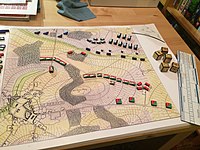콜린세테라제 3의 억제제에 대한 저항 으로도 알려진 RIC-3 는 인간에게 RIC3 유전자 에 의해 암호화된 체퍼론 단백질 이다. RIC3 유전자는 선충류 [5] RIC-3 단백질은 대부분의 동물에서 보존되며 세로토닌 5-HT3 수용체 와 니코틴 아세틸콜린 수용체 ,[6] [7] 호모메릭 α7 니코틴 수용체 를 포함한 다양한 리간드 게이트 이온 채널 의 성숙에 영향을 미친다. RIC-3는 세포 표면으로의 수용체 이동을 촉진하고 수용체 수를 증가시킴으로써 이들 수용체들이 생성하는 전류를 강화한다.[8]
참조 ^ a b c GRCh38: 앙상블 릴리스 89: ENSG00000166405 - 앙상블 , 2017년 5월^ a b c GRCm38: 앙상블 릴리스 89: ENSMUSG000048330 - 앙상블 , 2017년 5월^ "Human PubMed Reference:" . National Center for Biotechnology Information, U.S. National Library of Medicine .^ "Mouse PubMed Reference:" . National Center for Biotechnology Information, U.S. National Library of Medicine .^ Nguyen M, Alfonso A, Johnson CD, Rand JB (Jun 1995). "Caenorhabditis elegans mutants resistant to inhibitors of acetylcholinesterase" . Genetics . 140 (2): 527–35. doi :10.1093/genetics/140.2.527 . PMC 1206632 PMID 7498734 . ^ Halevi S, Yassin L, Eshel M, Sala F, Sala S, Criado M, Treinin M (Sep 2003). "Conservation within the RIC-3 gene family. Effectors of mammalian nicotinic acetylcholine receptor expression" . J Biol Chem . 278 (36): 34411–7. doi :10.1074/jbc.M300170200 PMID 12821669 . ^ "Entrez Gene: RIC3 resistance to inhibitors of cholinesterase 3 homolog (C. elegans)" .^ Williams ME, Burton B, Urrutia A, et al. (2005). "Ric-3 promotes functional expression of the nicotinic acetylcholine receptor alpha7 subunit in mammalian cells" . J. Biol. Chem . 280 (2): 1257–63. doi :10.1074/jbc.M410039200 PMID 15504725 . 추가 읽기 Cheng A, Bollan KA, Greenwood SM, et al. (2007). "Differential subcellular localization of RIC-3 isoforms and their role in determining 5-HT3 receptor composition" . J. Biol. Chem . 282 (36): 26158–66. doi :10.1074/jbc.M703899200 PMID 17609200 . Castillo M, Mulet J, Gutiérrez LM, et al. (2007). "Role of the RIC-3 protein in trafficking of serotonin and nicotinic acetylcholine receptors". J. Mol. Neurosci . 30 (1–2): 153–6. doi :10.1385/JMN:30:1:153 . PMID 17192664 . S2CID 41109579 . Lansdell SJ, Gee VJ, Harkness PC, et al. (2005). "RIC-3 enhances functional expression of multiple nicotinic acetylcholine receptor subtypes in mammalian cells". Mol. Pharmacol . 68 (5): 1431–8. doi :10.1124/mol.105.017459 . PMID 16120769 . S2CID 12901942 . Castillo M, Mulet J, Gutiérrez LM, et al. (2005). "Dual role of the RIC-3 protein in trafficking of serotonin and nicotinic acetylcholine receptors" . J. Biol. Chem . 280 (29): 27062–8. doi :10.1074/jbc.M503746200 PMID 15927954 . Cheng A, McDonald NA, Connolly CN (2005). "Cell surface expression of 5-hydroxytryptamine type 3 receptors is promoted by RIC-3" . J. Biol. Chem . 280 (23): 22502–7. doi :10.1074/jbc.M414341200 PMID 15809299 . Bennett HM, Lees K, et al. (2012). "Xenopus laevis RIC-3 enhances the functional expression of the C. elegans homomeric nicotinic receptor, ACR-16, in Xenopus oocytes" . J. Neurochem . 123 (6): 911–8. doi :10.1111/jnc.12013 . PMC 3549563 PMID 22970690 . Koperniak TM, Garg BK, et al. (2013). "Cell-specific effects on surface α7 nicotinic receptor expression revealed by over-expression and knockdown of rat RIC3 protein" . J. Neurochem . 124 (3): 300–9. doi :10.1111/jnc.12095 PMID 23157401 . S2CID 12489865 . Ota T, Suzuki Y, Nishikawa T, et al. (2004). "Complete sequencing and characterization of 21,243 full-length human cDNAs" . Nat. Genet . 36 (1): 40–5. doi :10.1038/ng1285 PMID 14702039 . Clark HF, Gurney AL, Abaya E, et al. (2003). "The secreted protein discovery initiative (SPDI), a large-scale effort to identify novel human secreted and transmembrane proteins: a bioinformatics assessment" . Genome Res . 13 (10): 2265–70. doi :10.1101/gr.1293003 . PMC 403697 PMID 12975309 . Strausberg RL, Feingold EA, Grouse LH, et al. (2003). "Generation and initial analysis of more than 15,000 full-length human and mouse cDNA sequences" . Proc. Natl. Acad. Sci. U.S.A . 99 (26): 16899–903. doi :10.1073/pnas.242603899 PMC 139241 PMID 12477932 .







